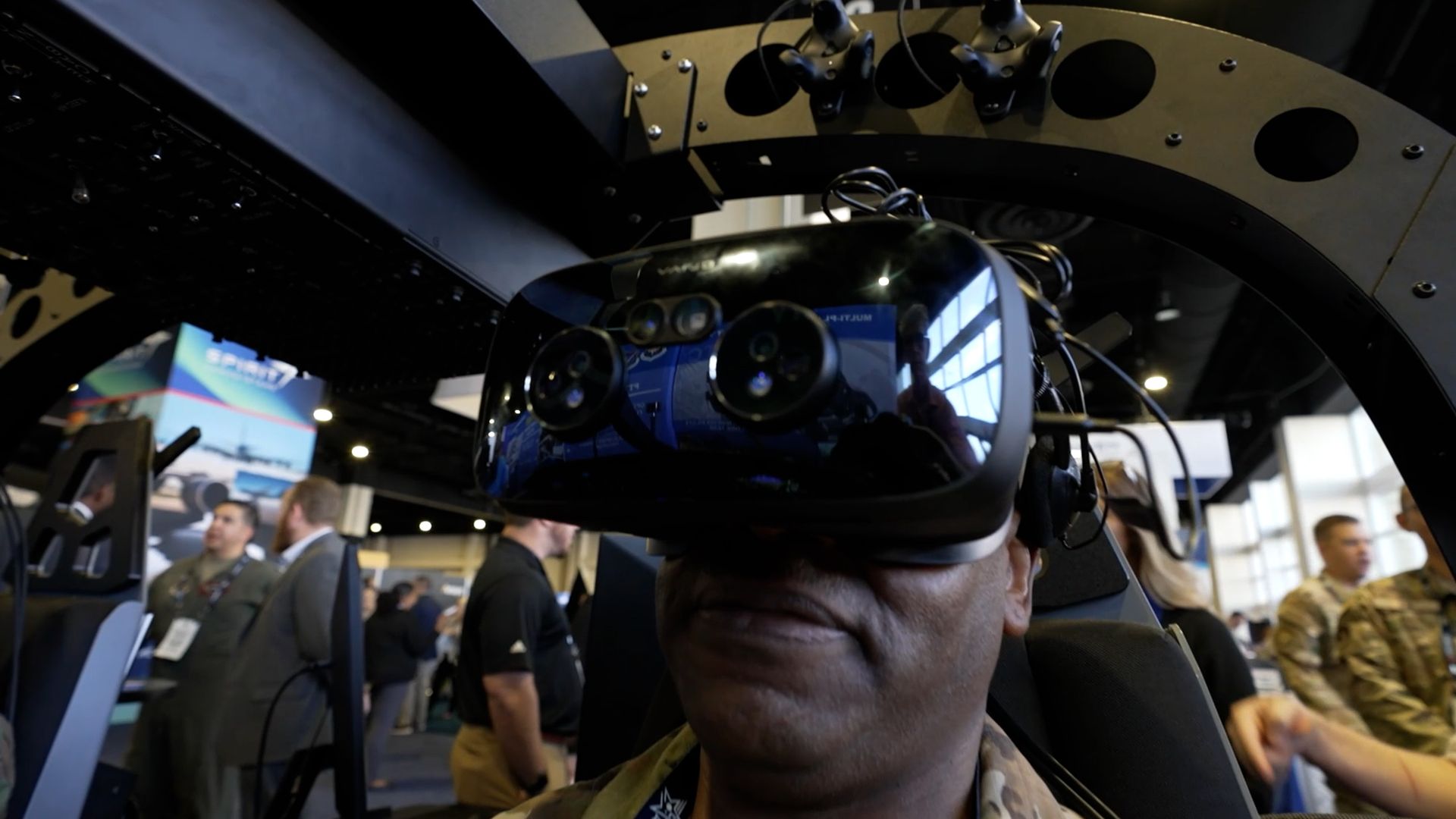
[RYAN ROBERTSON]
TRAINING. THE WORD ALONE CAN SEND EVEN THE MOST ENTHUSIASTIC OF PROFESSIONALS RUNNING FOR COVER. BUT NOT ALL TRAINING INVOLVES A BEIGE CONFERENCE ROOM AND A SPREAD OF STALE DONUTS. FOR SOME SOON-TO-BE PILOTS IN THE AIR FORCE, THE NEXT EVOLUTION OF TRAINING LOOKS LIKE SOMETHING STRAIGHT OUT OF ‘READY PLAYER ONE’
IT’S THE KIND OF SET-UP THAT WOULD LOOK RIGHT AT HOME IN A DAVE AND BUSTER’S. FOR AIRMEN TRAINING TO BECOME THE AIR FORCE’S NEXT GENERATION OF HELICOPTER PILOTS, THIS AUGMENTED REALITY IS THE NEW REALITY OF PILOT TRAINING.
[Maj. Paul Ferris]
It’s modeled off the TH-1H Huey helicopter. And it uses basically combined virtual and mixed reality environment where students are able to train and actually flip switches and see their hands.
[RYAN ROBERTSON]
THIS SYSTEM HAS BEEN IN USE BY THE AIR FORCE FOR A FEW YEARS NOW, AND THE PEOPLE INVOLVED SAY THE BENEFITS ARE NUMEROUS.
[Dennis Wilkoff | Vertex Solutions President, COO]
It best replicates the actual operational environment, it allows us to provide, essentially, on the job training.
[Maj. Paul Ferris]
We use it for all types of profiles, emergency procedures, training, instrument training, and then eventually what we’re trying to do is get it where we’ll have multiple devices that can be paired together, they supply information on a mission environment.
[RYAN ROBERTSON]
PERHAPS MOST OBVIOUS ADVANTAGE, IT’S A MORE COST EFFECTIVE WAY TO GET PROSPECTIVE PILOTS INTO A SEAT FOR MEANINGFUL HANDS ON TRAINING.
[Maj. Paul Ferris]
If you think about the normal simulators, they level the motion simulators, you know, those costs a lot of money for their for us, if we can have something you can see it’s a very small footprint. We can put it in in a student room, and students are able to use it and have easy access to it. That’s a big one for the Air Force.
[RYAN ROBERTSON]
THAT TRAINING IS ALSO HELPING GRADUATE STUDENT PILOTS AT A FASTER RATE. AN AIR FORCE TIMES ARTICLE FROM 2019 REPORTS THE FIRST CLASS TO PUT THIS TECHNOLOGY TO USE GRADUATED A FULL SIX WEEKS AHEAD OF SCHEDULE.
One of the truly great things about this multiplayer mixed reality trainer is the fact that it combines tactile feel with virtual reality. I have my cyclic, I have my collective, I have my tailrotor pedals and then when I put on my goggles, I’m fully immersed in a both mixed and virtual reality ahead of me, I can see what appears to be the airfield. But I also have all of my equipment right here at my side. And if I wanted to, I can take off.
[Dennis Wilkoff | Vertex Solutions President, COO]
The head mounted displays HMDs have video pass-through like 4k cameras that we can distinguish what pixels are looking at the physical environment, what pixels should be fired as a virtual reality. And that allows us to seamlessly mesh the physical environment, physical hands switches with a virtual reality output.
[RYAN ROBERTSON]
IN 2021 THE AIR FORCE OVERHAULED IT’S HELICOPTER TRAINING PROGRAM. SINCE THE EARLY 1990s HELICOPTER PILOTS HAD TO COMPLETE FIXED WING TRAINING BEFORE MOVING ONTO HELICOPTER TRAINING. THAT OLD REQUIREMENT IS NO LONGER IN PLACE.
[Maj. Paul Ferris]
And the reason behind that is you’re focusing on core competencies of being a helicopter pilot, I don’t need to teach a helicopter pilot how to go upside down or do anything like that. Or actually, you know, that would be very bad if he did. So by teaching them how to hover and the operation of flying the helicopter is really one that saves us lots of time, which translates to money overall. So we’ve really revitalized our pipeline.
[RYAN ROBERTSON]
IT’S A CHANGE, AT LEAST IN PART, THE AIR FORCE HOPES WILL LURE MORE PROSPECTIVE PILOTS TO SIGN ON THE DOTTED LINE. A RECENT REPORT IN THE SAN ANTONIO EXPRESS NEWS DETAILED THE BRANCH’S SHORTFALL OF 2,000 PILOTS. IT’S A PROBLEM THAT’S PUSHING AIR FORCE LEADERS TO GET APPROVAL FOR FIVE AND SIX FIGURE RETENTION BONUSES.
WHILE THAT’S NOT SOMETHING IMMEDIATELY AVAILABLE, THE OPPORTUNITY TO TRAIN WITH THE LATEST TECHNOLOGY IS.
[Dennis Wilkoff | Vertex Solutions President, COO]
I think this approach is really going to revolutionize aviation training in general. Once we can get to a level where we can get FAA certification, it will create the ability where now pilots don’t have to travel to a centralized training facility. We can because they’re lightweight, low cost, we can put this locally. And so pilots can get their check rides and simulators in their own neighborhoods, spend more time generating revenue flights. And so we’re going to see greater access to training makes better pilots.







